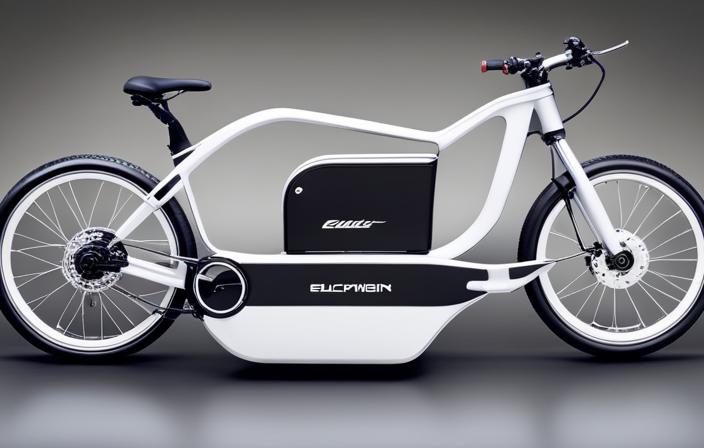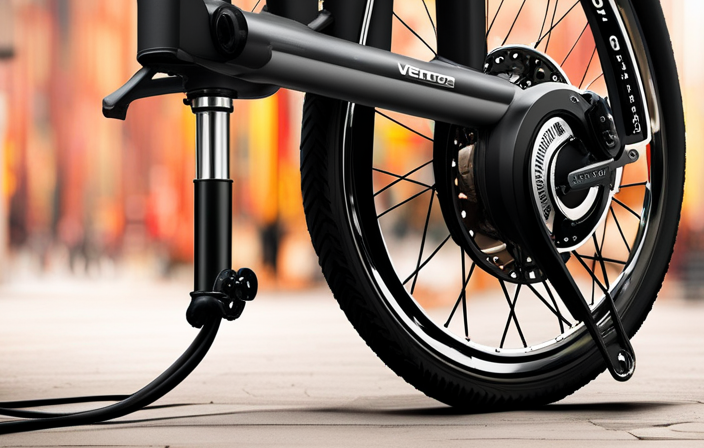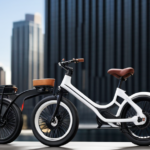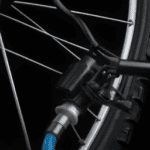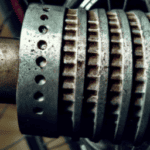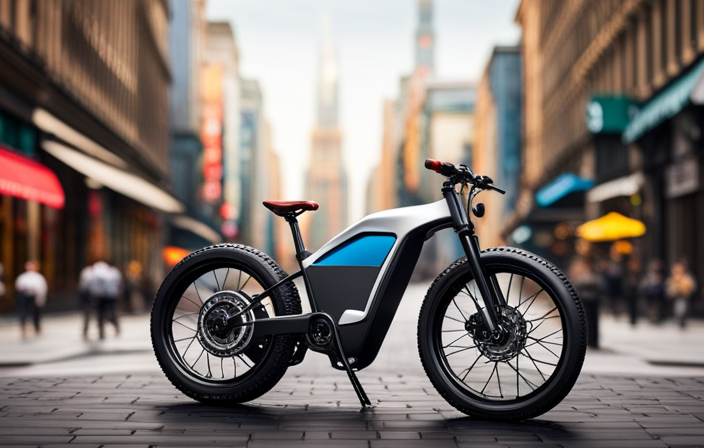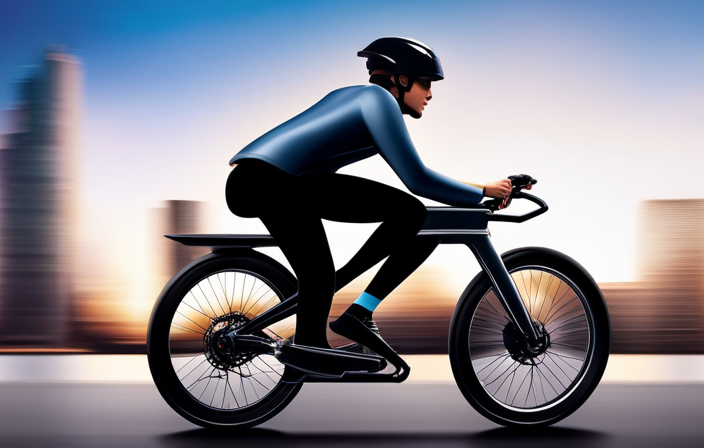Imagine the wind in your hair, the thrill of the open road, and the eco-friendly freedom of an electric bike. Like a modern-day superhero, an electric bike kit can transform your ordinary bicycle into a powerful, motorized machine.
But before you embark on this electrifying adventure, you may be wondering, ‘How much does an electric bike kit cost?’ In this article, I will dive deep into the world of electric bike kits, exploring the different types, performance factors, additional features, and most importantly, the price range and budget considerations.
Get ready to ride into the future!
Key Takeaways
- Electric bike kits can range in price from $200 to $1500 or more, with higher-priced kits offering advanced features and better quality.
- Bafang is a well-known brand in the conversion industry and offers reliable and powerful electric bike kits typically costing around $500.
- Swytch offers affordable electric bike kits that are easy to install, compatible with different bike types, and competitively priced.
- E-BikeKit provides seamless and efficient transitions to electric bikes, allowing riders to effortlessly tackle hills and longer distances while enjoying the benefits of a smoother ride and reduced car travel.
Types of Electric Bike Kits
There are different types of electric bike kits available in the market. These kits are designed to convert regular bicycles into electric bikes. One important factor to consider when choosing an electric bike kit is compatibility. Make sure the kit you choose is compatible with your bike’s frame and components.
Electric bike kits offer several advantages. First, they provide an affordable alternative to buying a new electric bike. You can simply upgrade your existing bike with a kit. Second, electric bike kits allow you to customize your ride according to your preferences. You can choose the motor power, battery capacity, and other features that suit your needs.
Now, let’s move on to the next section about motor power and performance, where we will explore how these factors impact the overall performance of an electric bike.
Motor Power and Performance
You can find electric bike kits with different motor powers and performance levels. When comparing motor power, it is important to consider the wattage. Higher wattage motors tend to provide more power and better performance.
Performance testing methods can help you determine the capabilities of a particular electric bike kit. These tests typically measure factors such as acceleration, top speed, and climbing ability. It’s also worth noting that motor power alone doesn’t guarantee superior performance. Other factors like the weight of the rider and terrain can also affect the overall performance.
As we move on to discussing battery capacity and range, it’s important to consider how motor power and performance work in conjunction with these aspects.
Battery Capacity and Range
When comparing electric bike kits, it’s essential to consider the battery capacity and range. The battery capacity determines how long the bike can run on a single charge, while the range refers to the distance it can cover before needing to be recharged.
A higher battery capacity means a longer battery life and allows you to ride for longer periods without worrying about running out of power. Additionally, a greater range ensures that you can travel further without needing to stop and recharge.
It’s important to note that battery life and charging time can vary depending on factors such as terrain, rider weight, and speed. Considering these factors will help you determine the most suitable electric bike kit for your needs.
Moving on to additional features and accessories, you’ll find even more ways to customize your electric bike experience.
Additional Features and Accessories
Consider adding additional features and accessories to enhance your electric biking experience.
There are a variety of options available to customize your electric bike kit. One popular accessory is a display panel that provides real-time information such as speed, battery level, and distance traveled. This allows you to easily monitor your ride and make necessary adjustments.
Another useful accessory is a rear rack, which provides a convenient place to carry items like groceries or a backpack. Additionally, you may want to invest in fenders to protect yourself from mud and water splashes.
There are also customization options available, such as different colors and designs for your bike frame. These additional accessories and customization options can make your electric biking experience more enjoyable and personalized.
Moving on to the next section about quality and brand reputation, it is important to consider these factors when choosing your electric bike kit.
Quality and Brand Reputation
To ensure a satisfying electric biking experience, it’s important to prioritize the quality and reputation of the brand you choose for your kit. When it comes to electric bike kits, there are numerous brands to choose from, each with their own unique features and customer satisfaction ratings. Reading electric bike kit reviews can provide valuable insights into the quality and reliability of a particular brand. Customers often share their experiences and opinions, giving you a better understanding of the product’s performance and durability. Additionally, considering the reputation of a brand is crucial. Established brands with a strong reputation for producing high-quality electric bike kits are generally a safer bet. Investing in a reputable brand can provide peace of mind and confidence in your purchase. Moving on to the next section about installation and maintenance, it’s essential to understand the steps required to ensure the longevity of your electric bike kit without compromising its performance.
Installation and Maintenance
When it comes to installing and maintaining an electric bike kit, there are a few key points to consider.
First, you’ll need to decide whether to take the DIY route or seek professional help. If you choose to do it yourself, make sure you have the necessary tools and equipment, such as wrenches, screwdrivers, and a torque wrench.
Additionally, routine maintenance, like checking the battery and motor, as well as troubleshooting tips for common issues, will ensure your electric bike kit operates smoothly and efficiently.
DIY Installation vs. Professional Help
Installing an electric bike kit yourself can save money, but it may be easier to seek professional assistance. When deciding whether to go the DIY route or hire a professional, there are a few factors to consider:
-
DIY vs. Professional cost: DIY installation typically costs less as you won’t have to pay for labor. However, keep in mind that if you make any mistakes during the installation, it could end up costing you more in the long run to fix them.
-
Pros of DIY installation: DIY allows you to learn about your electric bike kit and gain valuable skills. You can customize the installation to your preferences and have a sense of accomplishment.
-
Cons of DIY installation: It can be time-consuming and require technical knowledge. If you don’t have experience with electrical systems or bike mechanics, it may be challenging.
-
Professional help: Hiring a professional ensures that the installation is done correctly and efficiently. They have the expertise and tools needed to handle any challenges that may arise.
-
Transition: Once you’ve decided between DIY and professional installation, the next step is to gather the necessary tools and equipment for the job.
Now let’s move on to discussing the tools and equipment needed for installing an electric bike kit.
Tools and Equipment Needed
The tools and equipment needed for installing an e-bike kit can vary depending on the specific kit and installation instructions. However, there are some common tools and equipment recommendations that can help make the installation process smoother.
Firstly, a set of basic hand tools such as screwdrivers, wrenches, and pliers is essential. Additionally, a torque wrench is recommended to ensure that all bolts are tightened to the correct specifications. It is also important to have a wire cutter/stripper and electrical tape for properly connecting the wires.
Common installation mistakes include not tightening bolts enough or over-tightening them, which can lead to damage or malfunctioning of the electric bike kit. It is crucial to carefully follow the installation instructions provided with the kit to avoid these mistakes.
Once the installation is complete, routine maintenance and troubleshooting tips can help ensure the optimal performance of the e-bike kit. [Transition sentence into the subsequent section about routine maintenance and troubleshooting tips.]
Routine Maintenance and Troubleshooting Tips
For optimal performance of the e-bike kit, it’s important to regularly maintain and troubleshoot any issues that may arise. Common troubleshooting issues with electric bike kits include motor malfunctions, battery problems, and electrical wiring faults.
To address these issues, it is recommended to first check the motor connections, ensuring they are secure and properly aligned. If the motor is still not functioning, checking the battery voltage and connections is crucial. Best practices for battery maintenance include charging the battery regularly, avoiding extreme temperatures, and storing it in a cool, dry place. Additionally, it is important to inspect the electrical wiring periodically for any signs of damage or loose connections.
By following these maintenance and troubleshooting tips, you can ensure the longevity and efficiency of your e-bike kit.
Now, let’s move on to price range and budget considerations.
Price Range and Budget Considerations
When looking to purchase an electric bike kit, it’s important to consider your budget and the price range that fits within it. Electric bike kits can vary in price depending on the brand, features, and quality. It’s always a good idea to do a price comparison to find the best budget options available.
Some electric bike kits can be as low as $200, while others can go up to $1500 or more. The price range you choose will depend on your specific needs and preferences. Keep in mind that higher priced kits often come with more advanced features and better quality components.
However, if you’re on a tight budget, there are still options available that offer good performance and reliability. Now, let’s move on to the next section where we’ll discuss the comparison of popular electric bike kit brands.
Comparison of Popular Electric Bike Kit Brands
When it comes to electric bike kits, there are several popular brands worth considering.
Bafang is known for its high-quality and powerful motors, making it a reliable choice for those looking for a boost in performance.
Swytch offers a unique and versatile kit that can be easily installed on any bike, making it a convenient option for those who want to convert their existing bike into an electric one.
E-BikeKit is another reputable brand that offers a range of kits with different power options, allowing users to customize their electric bike to their specific needs and preferences.
Overall, these brands provide reliable and efficient electric bike kits that can enhance your riding experience.
Bafang
The Bafang electric bike kit typically costs around $500.
Bafang is a well-known brand in the electric bike conversion industry, offering high-quality kits that are popular among enthusiasts.
Their kits include a motor, battery, controller, and display, providing everything you need to convert your regular bike into an electric one.
The Bafang kit is known for its reliability and performance, with a powerful motor that can easily assist you in your rides.
It offers different options in terms of motor power and battery capacity, allowing you to choose the one that best suits your needs.
The Bafang kit is also compatible with various bike types, ensuring a seamless installation process.
Moving on to the next brand, let’s talk about Swytch.
Swytch
If you’re looking for a convenient and affordable way to convert your regular bike into an electric one, you should definitely check out the Swytch conversion kit. Swytch offers one of the most affordable options when it comes to electric bike kits. Their kits provide a cost-effective solution for those who want to experience the benefits of an electric bike without breaking the bank.
Here are three reasons why the Swytch conversion kit is worth considering:
-
Competitive Pricing: Swytch offers their kits at a fraction of the cost compared to other brands, making it a budget-friendly option for those on a tight budget.
-
Easy Installation: The Swytch conversion kit is designed for easy installation, allowing even beginners to transform their regular bikes into electric ones with minimal effort.
-
Versatile Compatibility: The Swytch kit is compatible with a wide range of bike types, including road bikes, mountain bikes, and folding bikes, providing flexibility and convenience for riders of all kinds.
With its affordable options and user-friendly features, the Swytch conversion kit is a great choice for anyone looking to enjoy the benefits of an electric bike.
Moving on to the next section about ‘e-bikekit’, let’s explore another option in the market.
E-BikeKit
E-BikeKit offers a range of options for converting regular bikes into electric ones. Their e bike conversion kits are designed to provide a seamless and efficient transition to an electric bike. These kits include everything you need to transform your bicycle into a powerful and eco-friendly mode of transportation.
One of the major benefits of electric bike kits is the ability to effortlessly tackle hills and longer distances with ease. The electric motor provides an extra boost, making your ride smoother and more enjoyable. Additionally, e bike kits are environmentally friendly, as they produce zero emissions and reduce the need for car travel.
With E-BikeKit, you can easily upgrade your bike and start reaping the benefits of electric biking. So, where can you buy these convenient electric bike kits?
Where to Buy Electric Bike Kits
Looking to buy an electric bike kit? Well, you’re in luck because there are several great options available. One popular choice is the E-BikeKit, which offers a range of high-quality electric bike kits to suit different needs and preferences.
When it comes to purchasing an electric bike kit, you have a few options to consider. Here are three places where you can buy electric bike kits:
- Local bike shops: Many local bike shops now carry electric bike kits, allowing you to see and test them in person before making a purchase.
- Online retailers: There are numerous online retailers specializing in electric bike kits, offering a wide range of options and competitive prices.
- Manufacturer websites: Some electric bike kit manufacturers also sell their products directly on their websites, providing a convenient way to browse and purchase.
Using an electric bike kit has several advantages. It allows you to transform your existing bike into an electric one, saving you money compared to buying a new electric bike. Additionally, electric bike kits are generally easy to install and can provide a boost to your regular cycling, making hills and long distances more manageable.
In conclusion, there are various places where you can buy electric bike kits, including local bike shops, online retailers, and manufacturer websites. Exploring these options will help you find the perfect electric bike kit for your needs and enjoy the many benefits it brings.
Conclusion and Final Recommendations
In conclusion, exploring the various options available for purchasing electric bike kits will help you find the perfect one for your needs and enjoy all the benefits it offers.
When considering whether to opt for a DIY installation or professional installation, it is important to weigh the pros and cons. DIY installation may be more cost-effective, but it requires technical skills and knowledge of bike mechanics. On the other hand, professional installation ensures proper assembly and reduces the risk of errors.
Once your electric bike kit is installed, routine maintenance is crucial to keep it running smoothly. Regularly check the battery levels and ensure they are charged properly. Clean the bike regularly to prevent dirt and debris from affecting its performance. Additionally, inspect the brakes, tires, and chain for any signs of wear and tear.
Proper maintenance will extend the lifespan of your electric bike kit and ensure a safe and enjoyable riding experience.
Frequently Asked Questions
Are electric bike kits legal to use on public roads?
Yes, electric bike kits are legal to use on public roads as long as they comply with electric bike regulations. They offer benefits such as increased speed, extended range, and reduced effort required for pedaling.
Can an electric bike kit be installed on any type of bicycle?
Installing an electric bike kit on any bike is like giving it a turbo boost. It enhances compatibility and unlocks a world of benefits like increased speed, extended range, and effortless hill climbing.
How long does it take to install an electric bike kit?
Installing an electric bike kit typically takes around 2-4 hours, depending on your experience and the complexity of the kit. Basic tools like wrenches, screwdrivers, and pliers are usually needed for the installation process.
Are there any safety precautions or regulations to consider when using an electric bike kit?
When using an electric bike kit, it is important to follow safety measures such as wearing a helmet, using proper brakes, and obeying traffic laws. Additionally, check local legal requirements for speed limits and registration.
Can an electric bike kit be removed and used on another bicycle?
Yes, an electric bike kit can be removed from one bicycle and used on another. However, it is important to ensure compatibility with the different bike’s specifications and components before doing so.
Conclusion
In conclusion, after exploring the different types of electric bike kits, considering motor power and battery capacity, and weighing the importance of additional features and brand reputation, it is clear that the cost of an electric bike kit can vary significantly.
Prices can range from $500 to $3000, depending on the quality and functionality of the kit. It is essential to set a budget and carefully compare different brands to ensure you find the best value for your money.
Remember, investing in a reliable and reputable brand is crucial for a long-lasting and enjoyable electric biking experience.
